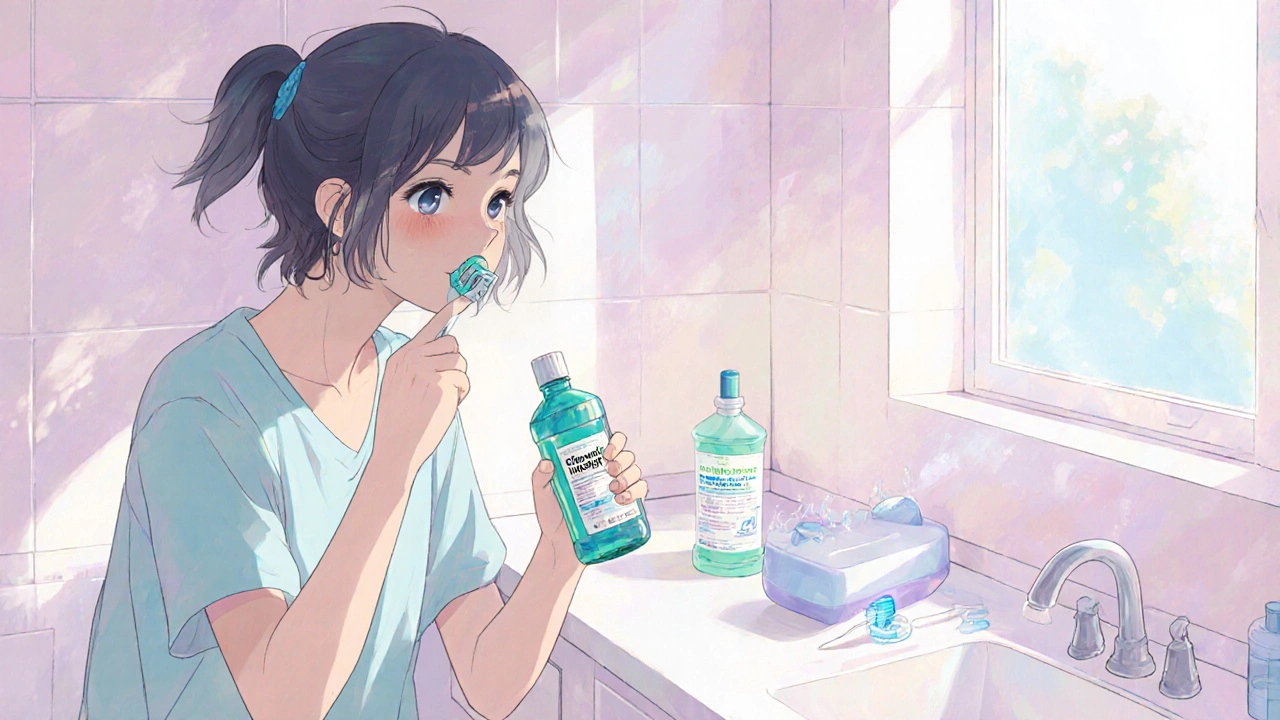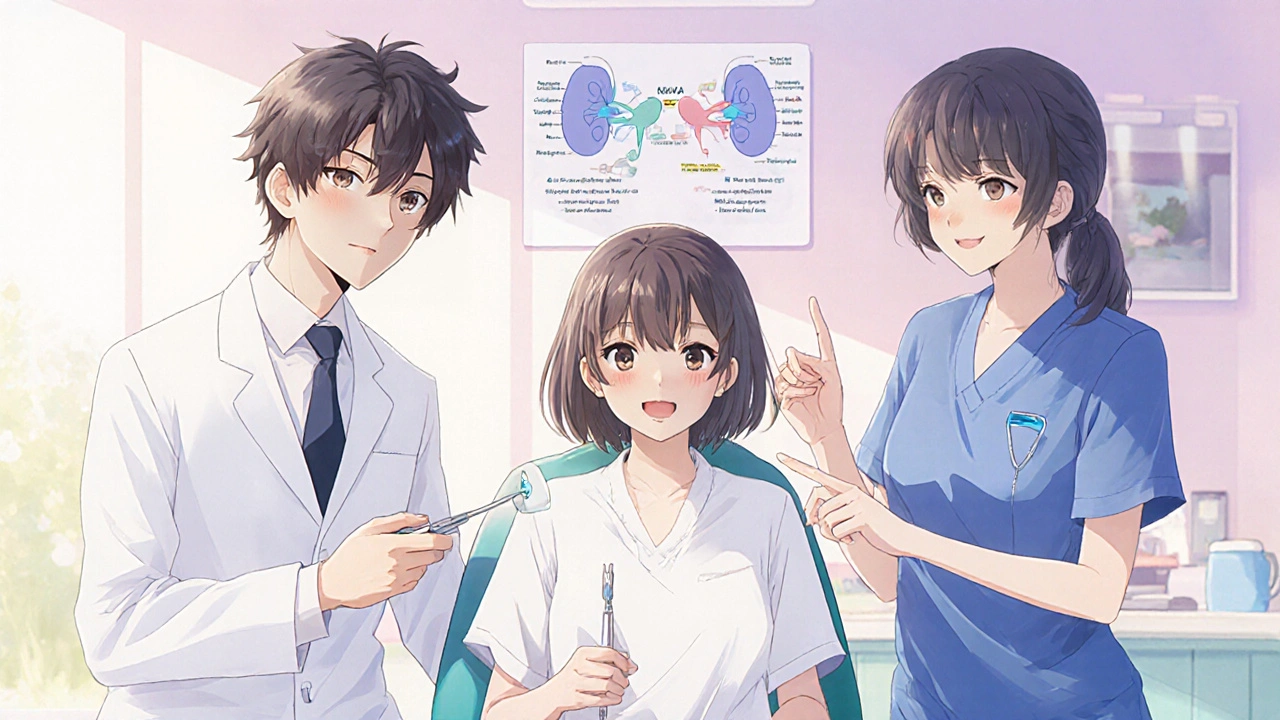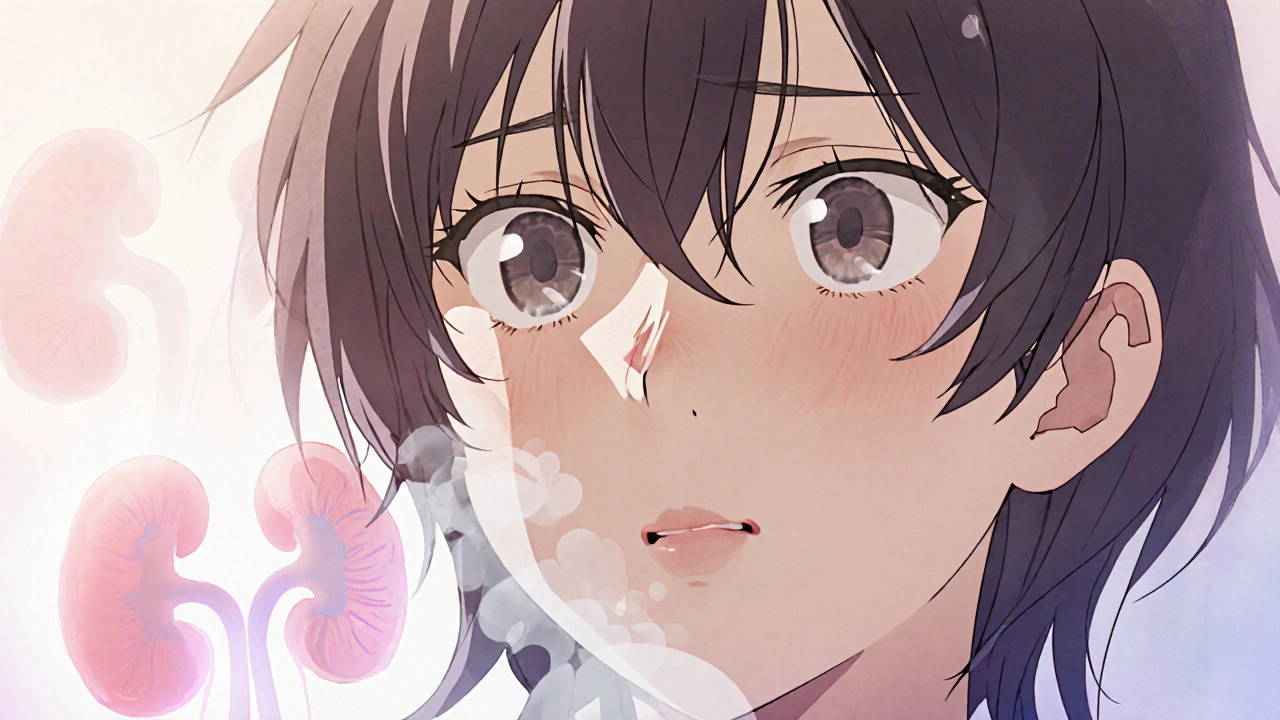Oral Health Risk Calculator
How your habits affect oral health
This calculator helps you assess your risk of oral complications based on your kidney disease management and dental care practices. Understanding your risk level helps you prioritize daily habits.
Assess Your Risk
Your Results
After calculating your risk, recommendations will appear here.
Renal failure and dental health are more linked than most people realize. When your kidneys stop filtering waste efficiently, the whole body feels the impact - especially your mouth. This guide shows how to keep your smile bright while living with kidney disease.
Why kidney disease affects your mouth
Every organ relies on clean blood. In renal failure, toxins build up, causing a cascade of oral issues:
- Xerostomia (dry mouth) reduces natural cleansing, letting plaque stick.
- Elevated phosphate and calcium can lead to calcific deposits on gums.
- Uremic toxins give the breath a characteristic “uremic” odor, often called uremic breath.
- Weakened immunity makes infections, especially periodontal disease, more likely.
Understanding these pathways helps you target the right preventative steps.
Common oral problems in renal failure
People on dialysis or with late‑stage kidney disease frequently report the following:
- Gum bleeding and swelling - a sign of early periodontitis.
- Increased cavities - dry mouth lowers saliva’s buffering capacity.
- Oral ulcerations - thin mucosa reacts to uremic toxins.
- Altered taste - a metallic or salty taste can affect nutrition.
Each symptom has a practical fix, and most can be managed at home with the right routine.
Daily oral hygiene routine for kidney patients
Start with a baseline that any dentist would recommend, then add kidney‑specific tweaks.
- Brush twice daily with a soft‑bristle fluoride toothpaste. Fluoride helps remineralize enamel weakened by low salivary flow.
- Consider a chlorhexidine mouthwash (0.12%) once a day after brushing to curb plaque buildup.
- Use a silicone‑based oral moisturizer or sugar‑free chewing gum to stimulate saliva when dry mouth is severe.
- Floss carefully after each meal; if floss irritates inflamed gums, try a water‑flosser set on low pressure.
- Rinse with a diluted baking‑soda solution (½ teaspoon in a cup of water) weekly to neutralize acids from bacterial metabolism.
Consistency beats intensity - a short, thorough routine beats an occasional marathon cleaning.

Diet and fluid considerations that protect your teeth
Kidney disease already imposes strict limits on protein, phosphorus, potassium, and fluids. Your dental plan should respect those limits.
- Phosphorus‑rich foods like nuts and dairy can cause calcium‑phosphate deposits on gums; enjoy them in moderation.
- Avoid sugary drinks and fruit juices that feed oral bacteria. If you need flavor, sip water with a splash of lemon (watch potassium).
- Stay hydrated within your fluid allowance - a dry mouth accelerates decay.
- Choose oral‑friendly protein sources such as egg whites or low‑phosphorus fish (e.g., cod).
Balancing renal diet and dental health may need a dietitian’s help, but the payoff is fewer cavities and calmer gums.
When to see a dentist or nephrologist
Regular check‑ups are non‑negotiable, yet timing matters.
- Schedule a dental visit at least twice a year; inform the dentist about your dialysis schedule.
- If you notice persistent bleeding, pus, or severe pain, book an urgent appointment - infections can spread to the bloodstream.
- Discuss any oral medication with your nephrologist; some antibiotics are cleared differently in renal failure.
Co‑ordinated care between your nephrologist and dentist reduces the risk of complications during dialysis sessions.

Product recommendations tailored for kidney patients
| Product Type | Standard Recommendation | Kidney‑Specific Adjustments |
|---|---|---|
| Toothpaste | Fluoride, mild flavor | Low‑sodium, no harsh desensitizing agents |
| Mouthwash | Alcohol‑based, 30‑second rinse | Alcohol‑free chlorhexidine, 1‑minute rinse |
| Floss | Waxed or unwaxed | Gentle PTFE floss to avoid gum trauma |
| Saliva Substitute | None needed | Silicone gel or xylitol‑free spray |
| Chewing Gum | Sugar‑free mint | Xylitol‑free to keep potassium low |
Pick products that respect your fluid and electrolyte targets while still tackling plaque.
Quick reference checklist
- Brush with fluoride toothpaste twice daily.
- Use alcohol‑free chlorhexidine mouthwash once a day.
- Stay hydrated within prescribed limits.
- Limit high‑phosphorus snacks.
- Schedule dental exams every six months.
- Alert your dentist about dialysis days.
- Report any new mouth pain to your nephrologist promptly.
Frequently Asked Questions
Can dialysis cause gum bleeding?
Yes. The anticoagulants used during dialysis can thin the blood, making fragile gums bleed more easily. Good oral hygiene and gentle brushing help control the symptom.
Is it safe to use fluoride toothpaste if I have low calcium?
Fluoride strengthens enamel regardless of calcium levels, so it remains safe and recommended. Just avoid toothpaste with added calcium carbonate if you are on a strict calcium‑restricted diet.
How often should I replace my toothbrush?
Every three months, or sooner if the bristles fray. A worn brush can irritate gums already prone to inflammation.
Can I use a regular mouthwash with alcohol?
Avoid alcohol‑based rinses; they can dry out the mouth further. Choose an alcohol‑free chlorhexidine or fluoride rinse instead.
What signs indicate I need to see a dentist urgently?
Severe pain, swelling that doesn’t subside, pus, or a fever are red flags. Prompt treatment prevents systemic infections that can jeopardize dialysis.

hema khatri
October 23, 2025 AT 16:21Stay strong, keep brushing!!!
Jennell Vandermolen
October 24, 2025 AT 20:08Great points, make sure you schedule those dental check ups around your dialysis days to keep things smooth
Mike Peuerböck
October 25, 2025 AT 23:55Utilizing an alcohol‑free chlorhexidine mouthwash once daily can markedly reduce plaque accumulation in renal patients. The antiseptic action compliments the fluoride toothpaste by targeting uremic‑related bacteria. Patients should rinse for a full minute to ensure adequate contact time. Coupled with a gentle water‑flosser, this regimen mitigates gum bleeding associated with anticoagulants used during dialysis. Consistency remains paramount; a disciplined routine protects oral health and, by extension, systemic wellbeing.
Simon Waters
October 27, 2025 AT 03:41Some corporate labs push chlorhexidine as a miracle cure. It works, but it also masks deeper issues they don’t want you to see. Keep your eyes open.
Kajal Gupta
October 28, 2025 AT 07:28Hey folks, if dry mouth is giving you grief, try a silicone‑based oral moisturizer – it’s gentle yet effective. It won’t mess with your fluid limits and feels surprisingly professional in its consistency. Just a dab after brushing and you’ll notice the difference.
Zachary Blackwell
October 29, 2025 AT 11:15Don’t trust that sugar‑free gum they hand out at clinics – the sweeteners are part of a larger scheme to keep us dependent on synthetic additives. Stick to plain water or xylitol‑free options if you can.
prithi mallick
October 30, 2025 AT 15:01Remember, a smile is more than teeth it’s a reflection of inner peace; even when kidneys are struggling, caring for your mouth can bring a sense of control. Keep it up and dont forget to breathe deep.
Michaela Dixon
October 31, 2025 AT 18:48One of the most fascinating intersections of nephrology and dentistry lies in the way systemic toxins alter the microenvironment of the oral cavity, prompting a cascade of changes that most patients never anticipate. When the glomerular filtration rate declines, uremic compounds accumulate not only in the bloodstream but also seep into saliva, changing its pH and buffering capacity. This subtle shift encourages the proliferation of acid‑producing bacteria, which in turn accelerates enamel demineralization even in the presence of diligent brushing. Moreover, the chronic inflammation that accompanies renal insufficiency sensitizes the gingival tissues, making them hyperreactive to even light mechanical stimulation. As a result, a soft‑bristle brush used correctly can still provoke bleeding if the underlying capillary fragility is not addressed. The recommended chlorhexidine rinse acts as a broad‑spectrum antiseptic, yet its prolonged use may disturb the natural fungal flora, a trade‑off that patients must weigh with their healthcare team. Dietary restrictions further complicate the picture; limited potassium intake can reduce the consumption of fresh fruits that naturally cleanse the mouth, while phosphorus‑rich foods, if not moderated, contribute to calcific deposits on the gums. Hydration, within the prescribed fluid quota, becomes a therapeutic ally, because adequate salivary flow dilutes harmful metabolites and facilitates mechanical clearance of debris. Water‑flossers, set to low pressure, provide a gentle yet effective means of disrupting biofilm without traumatizing delicate gingivae. In addition, silicone‑based saliva substitutes offer a mucosal coating that mimics natural saliva’s lubricating properties, thereby alleviating xerostomia without adding extra sodium. For patients on dialysis, timing oral care sessions shortly after treatment capitalizes on the transient reduction in systemic inflammation, making tissues more resilient. Coordination between nephrologists and dentists ensures that prescribed antibiotics are appropriately dosed, preventing subtherapeutic exposure that could foster resistant oral pathogens. Regular biannual dental examinations serve as a checkpoint not only for oral health but also for early detection of systemic complications that may manifest orally. Ultimately, the synergy of meticulous hygiene, tailored product selection, and interdisciplinary communication forms a robust defense against the oral sequelae of renal failure, preserving both function and confidence for the individual. Embracing this comprehensive approach can transform the daily routine from a chore into a cornerstone of holistic wellbeing.